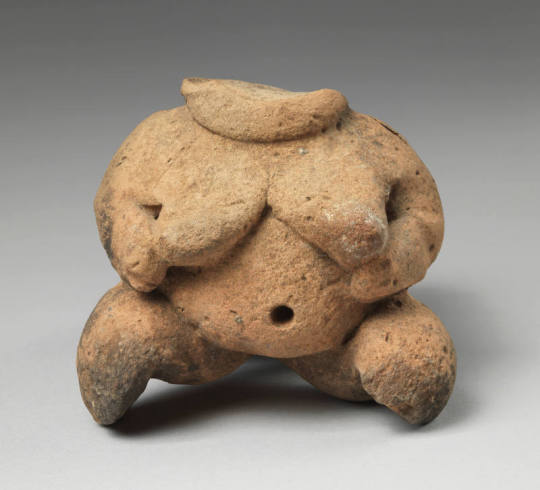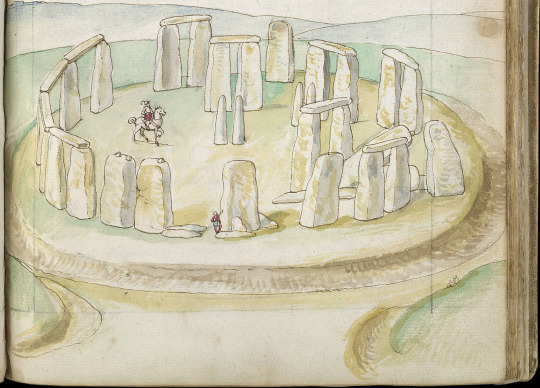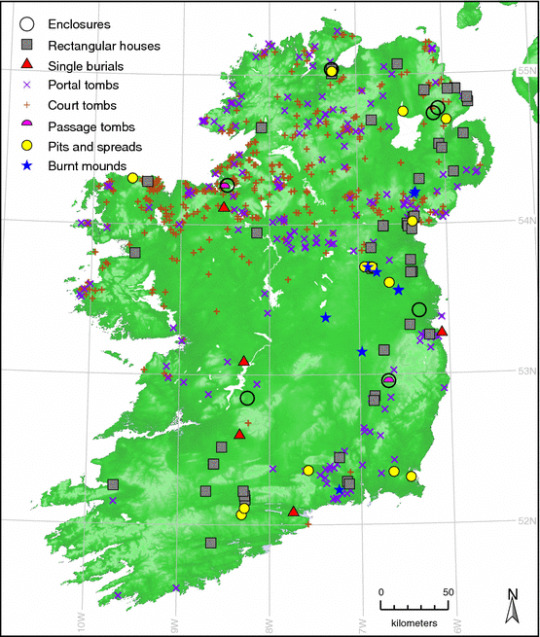#"neolithic
Text









Reconstructed Neolithic Burial and Pottery, Museum of North Lincolnshire, Scunthorpe
#ice age#stone age#bronze age#iron age#prehistoric#prehistory#neolithic#mesolithic#paleolithic#archaeology#pottery#prehistoric pottery#pottery fragments#burial mound#burial ground#burial chamber#grave goods#reconstruction#ancient cultures#ancient living#ancient crafts#skeleton#bones
56 notes
·
View notes
Text



A bigger decorative piece with cave painting handprints. River pebble and tempera
#miniature#painted stones#rock painting#cave art#rock art#pebbles#painted rocks#minerals#handprints#painted miniatures#neolithic#paleolithic#my art
13K notes
·
View notes
Text




An old comic I made in art school (14 years ago) about a papa and baby bear, as well as a neolithic human sacrifice
I'm calling it "Everybear knows"
3K notes
·
View notes
Text

~ Female Fertility Figurine.
Place of origin: Türkiye
Period: Neolithic
Date: 7th Millennium B.C.
Medium: Ceramic
#ancient#ancient art#history#museum#archeology#ancient sculpture#ancient history#archaeology#female fertility figurine#Neolithic#türkiye#turkish#ceramic#7th millennium B.C.
1K notes
·
View notes
Text

Hatsune Miku as a Cycladic idol from the Neolithic period. Reference used:

#vocaloid#greece#hatsune miku#cyclades#miku worldwide#miku world tour#cycladic idol#cycladic#cycladic civilization#greek history#bronze age aegean#bronze age#neolithic#artists on tumblr#tagamemnon#miku through the ages
668 notes
·
View notes
Text









Scenes from Neolithic life reconstructed by Andre Houot
#prehistory#stone age#anthropology#paleoart#paleoanthropology#neolithic#chalcolithic#switzerland#andre houot
411 notes
·
View notes
Text

shell necklace made of river mussels
stroked pottery culture, 4800-4400 BC
found in Šárka, Czech Republic
#neolithic#prehistory#stone age#artefact#archaeology#jewellery#stroked pottery culture#czech republic#archeology#my upl#central europe#european prehistory
433 notes
·
View notes
Text

Cave Art of Banging, Algeria, c. 7000 BCE
2K notes
·
View notes
Text

Lucas de Heere (1534–1584)
English: One of the earliest near-accurate depictions of Stonehenge.
Date between 1573 and 1575
watercolor
British Library
#english imagination#art#english culture#english art#english landscape#pagan#stonehenge#Wiltshire#England#Neolithic#stone age#pre-Christian#sacred#sacred landscape#sacred stones#standing stones#stone circle
332 notes
·
View notes
Text
A system of ancient ceramic water pipes, the oldest ever unearthed in China, shows that neolithic people were capable of complex engineering feats without the need for a centralized state authority, finds a new study by University College London researchers.
In a study published in Nature Water, the archaeological team describe a network of ceramic water pipes and drainage ditches at the Chinese walled site of Pingliangtai dating back 4,000 years to a time known as the Longshan period. The network shows cooperation among the community to build and maintain the drainage system, though no evidence of a centralized power or authority.
Dr. Yijie Zhuang (UCL Institute of Archaeology), senior and corresponding author on the paper, said, "The discovery of this ceramic water pipe network is remarkable because the people of Pingliangtai were able to build and maintain this advanced water management system with stone age tools and without the organization of a central power structure. This system would have required a significant level of community-wide planning and coordination, and it was all done communally."
The ceramic water pipes make up a drainage system which is the oldest complete system ever discovered in China. Made by interconnecting individual segments, the water pipes run along roads and walls to divert rainwater and show an advanced level of central planning at the neolithic site.
What's surprising to researchers is that the settlement of Pingliangtai shows little evidence of social hierarchy. Its houses were uniformly small and show no signs of social stratification or significant inequality among the population. Excavations at the town's cemetery likewise found no evidence of a social hierarchy in burials, a marked difference from excavations at other nearby towns of the same era.
But, despite the apparent lack of a centralized authority, the town's population came together and undertook the careful coordination needed to produce the ceramic pipes, plan their layout, install and maintain them, a project which likely took a great deal of effort from much of the community.
The level of complexity associated with these pipes refutes an earlier understanding in archaeological fields that holds that only a centralized state power with governing elites would be able to muster the organization and resources to build a complex water management system. While other ancient societies with advanced water systems tended to have a stronger, more centralized governance, or even despotism, Pingliangtai demonstrates that was not always needed, and more egalitarian and communal societies were capable of these kinds of engineering feats as well.
974 notes
·
View notes
Text


Iron Age Decorated Bronze Armlet, 50 to 200 CE, Trimontium Museum, Melrose
#ice age#stone age#bronze age#iron age#prehistoric#prehistory#neolithic#mesolithic#paleolithic#archaeology#armlet#jewellery#ancient cultures#ancient living#ancient crafts#trimontium#Melrose
57 notes
·
View notes
Text

Carreg Samson, North Pembrokeshire
April 2024
#not Carreg Samsung as I kept calling it#own photo#neolithic burial chamber#history#historic momument#burial chamber#prehistoric#coast#irish sea#or maybe it's still the celtic sea there#cymru#dolmen#wales#welsh history#ancient#neolithic#ancient and forever#I haven't had chance to research the history yet#original photography#nature#lensblr
315 notes
·
View notes
Text


Making big stone portals now. Probably due to subconscious irrational hope it will teleport me the hell out of here (motherland wants me out of existence again)
#epoxy resin art#epoxy resin#miniature#diorama#stone circle#cromlech#megaliths#neolithic#portal#magic#fantasy art#standing stones#sculpture#my art
592 notes
·
View notes
Text
Time Travel Question 52: Medievalish and Earlier
These Questions are the result of suggestions a the previous iteration. This category may include suggestions made too late to fall into the correct earlier time grouping. In some cases a culture lasted a really long time and I grouped them by whether it was likely the later or earlier grouping made the most sense with the information I had.
Please add new suggestions below if you have them for future consideration. All cultures and time periods welcome.
We already did the burnings which lost their bracket, but the culture lasted a long time across a big area, and people keep suggesting it.
#Time Travel#Passenger Pigeons#Extinct Species#Birds#North American History#Natural History#Pleistocene#Aotearoa#Moa#Haast's Eagle#Indigenous History#Māori History#Māori Folklore#Māori#Silphium#Ancient World#Neolithic#Cucuteni–Trypillia Culture#Kazakhstan#Archaeology#Bronze Age#History of Disease#Fiber Art#neanderthal#homins#Early humans#History of Fashion
261 notes
·
View notes
Text
Prehistoric Mirrors from Turkey, c.6000 BCE: these are the oldest manufactured mirrors in the world, dating back about 8,000 years; they were meticulously crafted from pieces of obsidian

Two of the obsidian mirrors from Çatalhöyük (Turkey); this pair was found buried together back in 2012
At least eight of these obsidian mirrors have been found at Çatalhöyük, a Neolithic site located in Turkey. All of these mirrors date back about 8,000 years, and each one was crafted from a chunk of obsidian (volcanic glass) that was knapped into the shape of a disc and then meticulously polished with progressively finer abrasives until a smooth, slightly convex surface had been developed. Some of these mirrors can still produce remarkably clear reflections.
Sources & More Info:
The Archaeologist: World's Oldest Mirrors Found at Neolithic Çatalhöyük Site
Çatalhöyük Research Project: Archive Report from 2012 (PDF download)
Çatalhöyük Research Project: Main Website
The Past: Cyber Archaeology, How 3D Modeling is Unpeeling the Neolithic at Çatalhöyük
#archaeology#artifact#anthropology#neolithic#prehistoric#neolithic mirrors#anatolia#turkey#Çatalhöyük#human history#obsidian#volcanic glass#crafting#art#prehistoric art#human nature
785 notes
·
View notes
Photo

Neolithic sites in Ireland
308 notes
·
View notes